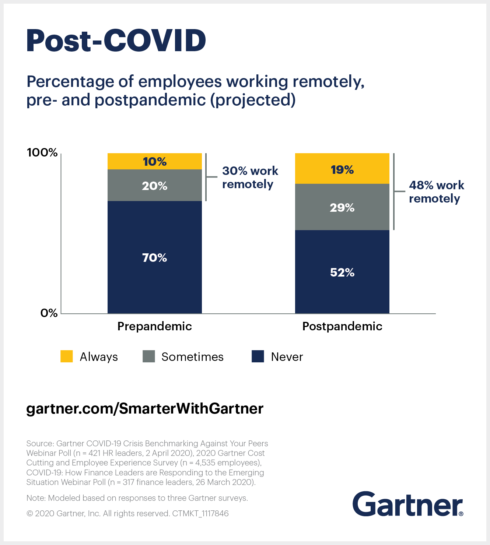
As organizations come to realize that employees likely will continue working remotely even after vaccines for the coronavirus are administered, the need for operations to happen remotely is among the six top trends Gartner has identified for infrastructure and operations (I&O) in 2021.
“The coronavirus pandemic has forced IT executives to adapt their operations to address increased work-from-home scenarios and unpredictable changes to IT requirements,” said Jeffrey Hewitt, research vice president at Gartner, at the company’s virtual IT Infrastructure, Operations & Cloud Strategies Conference Tuesday. “Yet, COVID-19 isn’t the only impetus for the majority of I&O staff to work from home moving forward. The nature of infrastructure is evolving to the point where remote I&O teams make sense to support new scenarios, use cases and technologies.”
Trend No. 1: Anywhere Operations
According to its research, Gartner expects that 48% of employees will work from home, even after the pandemic, compared to 30% pre-pandemic. This will require organizations to enable staff to work remotely, with access to the tools they need to do their jobs. Further, they will have to make sure customers can access services no matter where they are, and IT departments will have to manage service deployments across distributed infrastructures, Gartner outlined at the event.
“The traditional, structured processes within I&O made organizations fragile when it comes to the flexibility of location,” Hewitt said. “Anywhere operations enable organizations to decentralize staff and activate operations where it makes business sense. It even makes way for broader talent choices as organizations do not need to necessarily recruit staff in a specific geography.”
Trend No. 2: Optimal Infrastructure
“The key for anywhere operations is developing programmable infrastructure that enables the right work in the right place at the right time – this is the crux of optimal infrastructure,” said Hewitt. “As infrastructure and operations evolves into integration and operations, various solutions such as hyperconverged infrastructure or computational storage must be matched with the optimal use case.”
This will require the integration of data center and edge infrastructure to pull off, but that can lead to very complex deployments, so Hewitt said organizations should look at this from a business standpoint as it moves optimize costs and tools for a particular infrastructure deployment.
Trend No. 3: Operational Continuity
As employees and customers engage remotely, organizations will need to support them with continuous IT services that require minimal maintenance. Gartner research shows that by 2025, 60% of organizations will use automation tools to deploy new compute resources, reduce deployment time and deliver greater agility.
“When done correctly, this trend increases efficiencies and allows for faster workload deployment. The main downside is the learning curve that comes with using new and sometimes complex tools or processes that support continuity,” Hewitt explained.
Trend No. 4: Core Modernization
Maintaining core operations should be an ongoing process and not a one-time project, Hewitt said in his presentation, which will require coordinated on-premises and cloud infrastructures to minimize what the company has termed “legacy drag.”
“The upside of modernizing infrastructure is that it lowers technical debt and paves the way for agile infrastructure to respond to the growing list of digital business requirements,” Hewitt said. “Enterprises must implement a modernization plan with a realistic timeline, one which accounts for shifting skill requirements.”
Trend No. 5: Distributed Cloud
According to Gartner, shifting the burden of support to cloud service providers will be another major trend in 2021. Organizations should distribute cloud resources to decentralize the cloud, which will enable choice of locations and provide a reduction in latency.
“Since the distributed cloud market is currently immature, costs can be high and deployment models complex. Organizations should still have it on their horizon as a part of the future of cloud computing, since most cloud service platforms will provide at least some distributed cloud services that execute at the point of need over the next four years,” Hewitt noted.
Trend No. 6: Critical Skills Versus Critical Roles
“I&O skills requirements will continue to evolve as organizations adapt to new business environments,” he said. “Specifically, there is a shift in focus from infrastructure roles toward collective, critical skills. This challenges the traditional ‘territorial’ thinking of belonging to a specific infrastructure team and instead encourages collaboration.”
According to Gartner, by 2022, “I&O leaders can expect to plan for at least 12 high-priority skills in their organizations.” Those leaders should consider culture changes resulting from this shift from roles to skills in their planning, but are encouraged to “hire for these skills now while the IT talent market remains a buyer’s market.”








